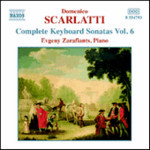
Keyboard Sonatas, Vol. 6
 $25.00
Out of Stock
$25.00
Out of Stock6+ weeks add to cart
DOMENICO SCARLATTI
Keyboard Sonatas, Vol. 6
Evgeny Zarafiants (piano)
[ Naxos / CD ]
Release Date: Wednesday 7 March 2007
This item is currently out of stock. It may take 6 or more weeks to obtain from when you place your order as this is a specialist product.
Domenico Scarlatti was born in Naples in 1685, sixth of the ten children of the composer Alessandro Scarlatti, Sicilian by birth and chiefly responsible for the early development of Neapolitan opera.
The Scarlatti family had extensive involvement in music both in Rome and in Naples, where Alessandro Scarlatti became maestro di cappella to the Spanish viceroy in 1684. Domenico Scarlatti started his public career in 1701 under his father's aegis as organist and composer in the vice-regal chapel. The following year father and son took leave of absence to explore the possibilities of employment in Florence, and Alessandro was later to exercise paternal authority by sending his son to Venice, where he remained for some four years. In 1709 Domenico entered the service of the exiled Queen of Poland, Maria Casimira, in Rome, there meeting and playing against Handel in a keyboard contest, in which the latter was declared the better organist and Scarlatti the better harpsichordist. It has been suggested that he spent a period from 1719 in Palermo, but his earlier connection with the Portuguese embassy in Rome led him before long to Lisbon, where he became music-master to the children of the royal family. This employment took him in 1728 to Madrid, when his pupil the Infanta Maria Barbara married the heir to the Spanish throne. Scarlatti apparently remained there for the rest of his life, his most considerable achievement the composition of some hundreds of single-movement sonatas or exercises, designed largely for the use of the Infanta, who became Queen of Spain in 1746.
The keyboard sonatas of Domenico Scarlatti survive in part in a number of eighteenth century manuscripts, some clearly from the collection of Queen Maria Barbara, possibly bequeathed to the great Italian castrato Farinelli, who was employed at the Spanish court, and now in Venice. Various sets of sonatas were published during the composer's lifetime, including a set of thirty issued in Venice or, perhaps, in London in 1738, and 42 published in London by Thomas Roseingrave in 1739, including the thirty already available from the earlier publication. In more recent times the sonatas were edited by Alessandro Longo, who provided the numerical listing under L, and in 1953 the American harpsichordist Ralph Kirkpatrick provided a new listing, distinguished by the letter K. Stylistic grounds have suggested a further changed listing by Giorgio Pestelli, under the letter P.
Tracks:
Keyboard Sonata in E major, K.135/L.224/P.234: Allegro
Keyboard Sonata in A major, K.429/L.132/P.132: Allegro
Keyboard Sonata in D major, K.478/L.12/P.503: Andante cantabile
Keyboard Sonata in G major, K.169/L.331/P.247: Allegro
Keyboard Sonata in G major, K.259/L.103/P.469: Andante
Keyboard Sonata in C major, K.502/L.3/P.408: Allegro
Keyboard Sonata in F major, K.419/L.279/P.524: Presto
Keyboard Sonata in F major, K.19/L.383/P.75: Allegro
Keyboard Sonata in B flat major, K.112/L.298/P.94: Allegro
Keyboard Sonata in E flat major, K.123/L.111/P.180: Allegro
Keyboard Sonata in F major, K.274/L.297/P.491: Andante
Keyboard Sonata in A major, K.405/L.43/P.436: Allegro
Keyboard Sonata in F sharp major, K.318/L.31/P.302: Andante
Keyboard Sonata in F sharp minor, K.67/L.32/P.125: Allegro
Keyboard Sonata in C sharp minor, K.247/L.256/P.297: Allegro
Keyboard Sonata in G major, K.63/L.84/P.32: Allegro



